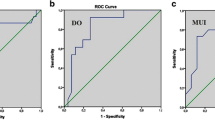Abstract
Purpose
The aim of the current study was to evaluate the diagnostic accuracy of transvaginal ultrasound measurement of bladder wall thickness (BWT) in diagnosis of over active bladder (OAB).
Methods
The current prospective study was conducted at Ain Shams University Maternity Hospital over 2 years. Patients presented to the urogynecology outpatient clinic with symptoms of urinary frequency, urgency, nocturia and/or urge incontinence were included in this study. The allocated patients were divided into two groups; Group 1(study group): fifty (50) patients with urodynamic diagnosis of detrusor instability (OAB) were included. Group 2 (control): fifty (50) patients with urodynamic diagnosis of stress incontinence were included. Using a transvaginal probe, BWT was measured in three sites at the thickest part of (a) the dome of the bladder (b) the trigone, and (c) the anterior wall of the bladder. An average of the three measurements was considered as the mean bladder thickness.
Results
A total of 100 patients with lower urinary symptoms were finally analyzed. There were no statistical significant differences between both groups regarding age, parity and body mass index, while there was statistically longer disease duration in group 2. Excluding urgency, there was statistical significant difference (P < 0.001) regarding lower urinary tract symptoms namely frequency, urgency incontinence, coital incontinence and nocturia. Patients in group 1 were more positive to symptoms of frequency, urgency incontinence, and nocturia, while patients in group 2 were more positive regarding coital incontinence. The thickness of trigon, dome, anterior wall and mean BWT was significantly higher in group 1 when compared to group 2. Receiver operator characteristics curve was constructed for estimating the association between mean BWT and prediction of OAB in patients with lower urinary tract symptoms. Mean BWT at 4.78 mm was considered as best cut-off value for prediction of OAB with sensitivity of 90 % and specificity of 78 %. Mean BWT was significantly associated with OAB > 4.78 mm as denoted by the significantly large area under the curve [AUC], AUC was 0.905.
Conclusion
In women with lower urinary tract symptom, transvaginal ultrasounds measured mean BWT seems to be an effective non invasive diagnostic tool for prediction of OAB.


Similar content being viewed by others
Abbreviations
- BMI:
-
Body mass index
- BWT:
-
Bladder wall thickness
- DO:
-
Detrusor overactivity
- ICS:
-
International Continence Society
- UI:
-
Urinary incontinence
- OAB:
-
Overactive bladder
- ROC:
-
Receiver operator characteristics
References
Cerruto MA, D’Elia C, Aloisi A, Fabrello M, Artibani W (2013) Prevalence, incidence and obstetric factors’ impact on female urinary incontinence in Europe: a systematic review. Urol Int 90(1):1–9
Rai BP, Cody JD, Alhasso A, Stewart L (2012) Anticholinergic drugs versus non-drug active therapies for non-neurogenic overactive bladder syndrome in adults. Cochrane Database Syst Rev 12:CD003193
Oelke M, Khullar V, Wijkstra H (2013) Review on ultrasound measurement of bladder or detrusor wall thickness in women: techniques, diagnostic utility, and use in clinical trials. World J Urol 31(5):1093–1104
Haylen BT, de Ridder D, Freeman RM, Swift SE, Berghmans B, Lee J et al (2010) International Urogynecological Association; International Continence Society. An International Urogynecological Association (IUGA)/International Continence Society (ICS) joint report on the terminology for female pelvic floor dysfunction. Neurourol Urodyn 29:4–20
Kuo HC (2009) Measurement of detrusor wall thickness in women with overactive bladder by transvaginal and transabdominal sonography. Int Urogynecol J Pelvic Floor Dysfunct 20(11):1293–1299
Robinson D, Anders K, Cardozo L, Bidmead J, Toozs-Hobson P, Khullar V (2002) Can ultrasound replace ambulatory urodynamics when investigating women with irritative urinary symptoms? BJOG 109(2):145–148
Lekskulchai O, Dietz HP (2008) Detrusor wall thickness as a test for detrusor overactivity in women. Ultrasound Obstet Gynecol 32(4):535–539
Penson DF, Litwin MS (2005) Quality-of-life issues. In: Sandip P. Vasavada, Rodney A. Appell, Peter K Sand, Shlomo Raz (eds) Incontinence female urology, urology, urogynecology, and voiding dysfunction, 1st edn. vol 4. Marcel Deker New York pp 53-64
Hill P (2002) Can ultrasound replace ambulatory urodynamics when investigating women with irritative urinary symptoms? BJOG 109(12):1422
Khullar V, Cardozo LD, Salvatore S, Hill S (1996) Ultrasound: a noninvasive screening test for detrusor instability. Br J Obstet Gynaecol 103(9):904–908
Soligo M, Khullar V, Salvatore S, Luppino G, Arcari V, Milani R (2002) Overactive bladder definition and ultrasound measurement of bladder wall thickness: the right way without urodynamics. Neurourol Urodyn 21(4):284–285
Latthe PM, Champaneria R, Khan KS (2010) Systematic review of the accuracy of ultrasound as the method of measuring bladder wall thickness in the diagnosis of detrusor overactivity. Int Urogynecol J 21(8):1019–1024
Conflict of interest
No author has any potential conflict of interest.
Author information
Authors and Affiliations
Corresponding author
Rights and permissions
About this article
Cite this article
Abou-Gamrah, A., Fawzy, M., Sammour, H. et al. Ultrasound assessment of bladder wall thickness as a screening test for detrusor instability. Arch Gynecol Obstet 289, 1023–1028 (2014). https://doi.org/10.1007/s00404-013-3092-5
Received:
Accepted:
Published:
Issue Date:
DOI: https://doi.org/10.1007/s00404-013-3092-5




